A Comprehensive Comparison of Various LED Video Screen Technologies and The Applications
A Comprehensive Comparison of Various LED Video Screen Technologies and The Applications
Blog Article
LED video screens have become more popular in various settings, such as music events, athletic events, and corporate presentations. These big screens are made up of many small LED modules which function collectively to form a cohesive unified visual. Various different types of LED video wall solutions on the market, every having its unique characteristics as well as advantages. Grasping these technologies options can help businesses as well as organizations choose the right solution for their specific needs.
A common type of Light Emitting Diode display wall technology is the direct view LED. Such technology uses separate Light Emitting Diode modules which are arranged closely together to create a big screen. Directly viewed LED screens are recognized for their high brightness as well as lively colors, making them ideal for external activities or brightly lit environments. These displays also have a wide viewing angle, which means that people can see the screen distinctly from different locations. Such makes directly viewed LED screens a favored choice for stadiums as well as outdoor events.
A different type of Light Emitting Diode display screen technology is the LED-backlit Liquid Crystal Display. Such technology combines traditional Liquid Crystal Display displays and Light Emitting Diode backlighting to enhance brightness as well as hue precision. LED-backlit LCDs are commonly utilized in indoor environments, including retail malls and conference rooms. These displays provide excellent image clarity while are typically more cost-effective than direct view LED screens. However, they may often function as well in bright settings, since the backlighting can occasionally dull the hues.
Another thirdly option is the OLED video wall. OLED technology offers superior contrast as well as hue richness in relation to alternative kinds of screens. Every dot in an OLED read here screen emits its own light, allowing for true blacks and lively hues. This makes OLED video walls particularly appealing for applications that require high-quality visuals, such as art galleries and high-end shopping outlets. Nonetheless, Organic Light Emitting Diode technology can be more expensive and may not be as bright as direct view LED walls, making it less appropriate for outdoor use.
In addition to these options, various also various uses for Light Emitting Diode display screens. They can be used for advertising, amusement, as well as information display. For instance, companies often use Light Emitting Diode display walls for digital advertising to draw in customers as well as advertise products. In amusement, these displays enhance the visual encounter at music events and events, offering lively backgrounds and captivating visuals. Within business settings, LED display walls can be utilized for demonstrations, video meetings, as well as training programs, aiding to communicate data through a visually attractive manner.
In conclusion, Light Emitting Diode display walls are available in various technologies, each having its own advantages as well as applications. Direct view Light Emitting Diode walls are great for outdoor applications, while LED-backlit Liquid Crystal Displays are more suitable for indoor environments. OLED display screens offer exceptional visual quality but may be at a higher cost. Grasping these differences can assist organizations to make informed decisions about the best kind of Light Emitting Diode video screen best meets their requirements, whether for promotion, entertainment, or business use.